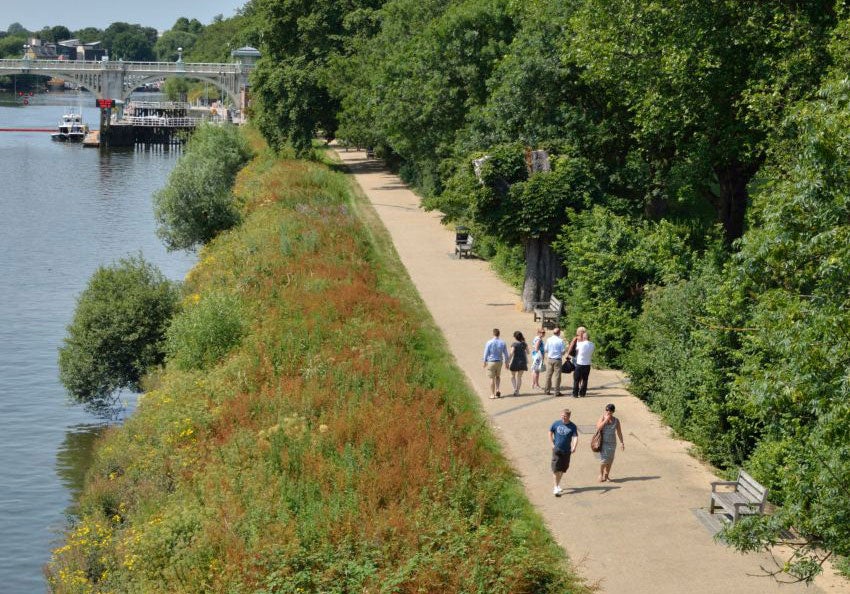Nature Studies: The magic wildlife kingdom that lies just on the edge of London
This year's Easter celebrations take place in a much later Spring than usual, making it the perfect time to enjoy a walk ripe with historical beauty

Easter is the most moveable of feasts, and when it occurs this Sunday – 20 April – it will be much later than normal (it can be as early as March 22). This means that spring will be far more advanced than it often is over an Easter weekend. There will be a lot more to see, in terms of the natural world.
So I am going to suggest an Easter outing, one which will satisfy a taste for heritage and a taste for nature at the same time, and it centres on the River Thames, just as it reaches the outskirts of London.
Although the Thames is a river which flows from West to East, from the Cotswolds to the North Sea, when it passes Hampton Court, Cardinal Wolsey’s palace which Henry VIII confiscated, it does a sharp left-hand turn and heads north for 11 miles until it gets to Kew, where it resumes its journey eastwards. And in heritage terms, this 11-mile north-south stretch is the richest portion of the whole river, containing at least nine great houses or stately homes; it is the nearest thing we have to the châteaux of the Loire in France.
It is also a wonderfully green valley on the capital’s edge, surprisingly full of wildlife which will be at its best over the next two months, and you can walk the length of it on the Thames Path, the national trail which follows the whole course of the river from its source in Gloucestershire to the Thames Barrier in East London. I suggest you concentrate on a stretch of four or five miles, going south from Kew Bridge and finishing in Richmond, Ham, Teddington or (if you want your money’s worth) Kingston upon Thames.
The historic houses you will pass are Kew Palace, Syon Park, Richmond Palace, Marble Hill House, Orleans House, York House, Ham House and Strawberry Hill (and you can walk on to Hampton Court if you wish).
All have a tale to tell: Kew Palace was where George III retreated to recover from his madness; Syon Park, then a nunnery, was where Henry VIII’s body fell out of its coffin, on the way to burial in Windsor; Richmond Palace was where three sovereigns of England died, the last being Elizabeth I in 1603; Marble Hill House was the home of the mistress of George II; Orleans House provided sanctuary for French aristocrats fleeing the Revolution; York House was the home of the Earl of Clarendon, historian of the English Civil War; Ham House, outstandingly beautiful, was the home of one of Charles II’s most prominent courtiers; and Strawberry Hill, built like an imitation Gothic Castle, was the home of the 18th-century man of letters, Horace Walpole.
You can visit them all. But the wildlife is as fascinating as the history on this walk. Waterbirds you will see on the river, especially at low tide, include herons, cormorants, mallards, tufted ducks, Canada geese, Egyptian geese (brown, with big white patches on their wings visible in flight), mute swans, coots, moorhens, black-headed gulls, herring gulls, lesser black-backed gulls and carrion crows and jackdaws picking over the tideline; and as you get nearer to Richmond you’ll probably see great-crested grebes.
Landbirds you will see (and hear) as you pass Kew Gardens on your left include the ubiquitous ring-necked parakeets, whose brilliant green plumage and loud scream are now among the most ubiquitous sights and sounds of this part of the world, as well as woodpigeons, jays, magpies, robins, wrens, dunnocks, song thrushes, blackbirds and not infrequently, sparrowhawks; and from now on, blackcaps, with the sweetest of all birdsongs.
The wild flowers you will see on the path, just out or just emerging, include white dead-nettle, comfrey, cow parsley, pimpernel, herb Robert, and bluebell, plus two favourites of mine: garlic mustard and lady’s smock. I love these last two even more as they are the food plants for the larva of the orange tip butterfly, that most heart-lifting sign of spring, and if the sun is out you’ll be unlucky not to see orange tips on this walk this weekend. You may also see peacocks, commas, brimstones and holly blues.
For some, of course, such a walk is too much, so I have an alternative suggestion: visit Kew itself, I mean the Royal Botanic Gardens. In the woodlands around Queen Charlotte’s cottage the bluebells are just coming out, already a blue haze under the trees: this weekend they should be at their peak. They’re breathtaking in their beauty. They’re there to be enjoyed. So enjoy them. Happy Easter.

Join our commenting forum
Join thought-provoking conversations, follow other Independent readers and see their replies